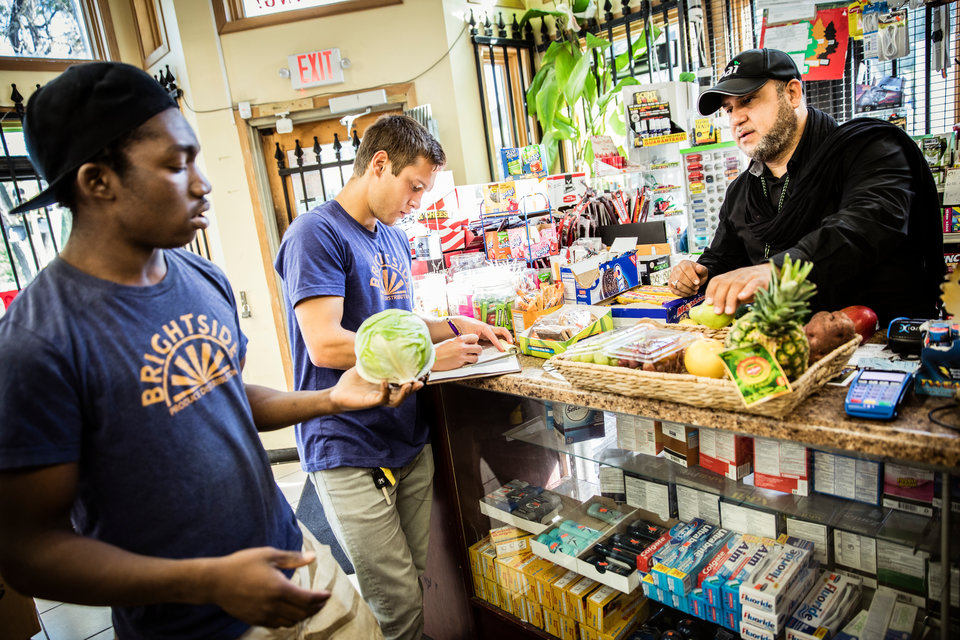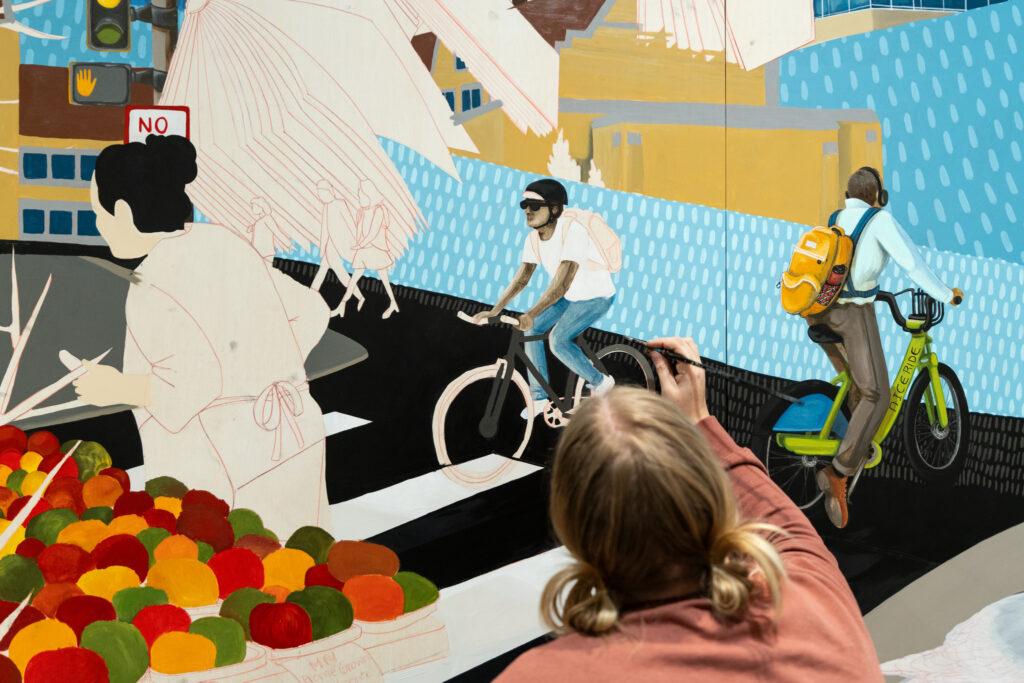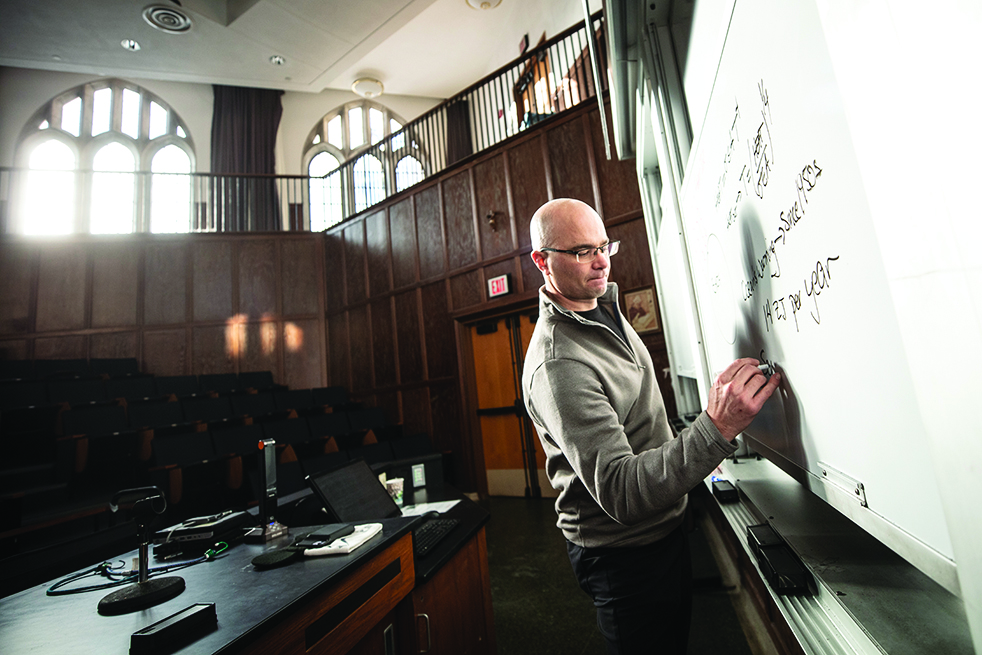The prevalence of food deserts across the United States is the kind of issue so large it can make your head spin. According to the U.S. Department of Agriculture (USDA), nearly 20 million Americans live in food deserts, defined as when at least 500 people, or 33 percent of a region’s population, live more than a mile from the nearest supermarket or grocery store. Such communities also are generally low income, further limiting the ability to access nutritious produce needed for a healthy life.
The issue is both nationwide and close to home: Huge swaths of northern Minnesota and areas of the Twin Cities are food deserts, according to the USDA. It’s a widespread, cyclical problem, and will require the implementation of replicable solutions on a massive scale to be fully addressed. First though, a model for possible solutions needs to be created. At the University of St. Thomas, BrightSide Produce is one of those solutions. A community partnership that provides fresh, affordable produce to corner stores in food deserts, it taps into St. Thomas and north Minneapolis students to help create the first economically sustainable model for addressing food deserts.
“It’s one of the coolest things I’ve ever done,” said St. Thomas senior Nicole Herrli, a BrightSide participant who has also completed research on the project through a St. Thomas community-based research grant. “It’s one of those things you’ll tell your kids some day: ‘In college I did this.’ It’s one of those things you’ll never forget.”
“I think we’re really on to something,” said Biology Associate Professor Adam Kay, who co-founded BrightSide Produce in 2015.

BrightSide Produce employee Steven Fuller organizes produce while making weekend deliveries to neighborhood stores for BrightSide Produce in Minneapolis.
Big problem, big solution
In 2008, Minneapolis became the country’s first city to enact a staple foods ordinance, which requires licensed grocery stores to have certain levels of quality produce available for purchase at all times. Included in that requirement are corner stores, which are often the only accessible grocery location for community members in food deserts. These stores can’t buy enough produce from wholesale vendors, so they end up buying from other retail stores. That means more expensive, lower quality produce for customers.
Three years ago Kay and Carly Dent ’15 began researching how they might address this problem. A partnership with Community Table – a Minneapolis nonprofit that supports entrepreneurs who contribute to a local food system – soon grew, and, along with then-high school student Adam Pruitt, BrightSide Produce was founded.
The model is this: BrightSide buys wholesale produce, which St. Thomas students and local high school students bring to corner stores around Minneapolis every Saturday. Store owners buy that produce at a much lower rate than they otherwise could, meaning they can provide better produce to customers at more affordable prices. At the end of every Saturday run, all the leftover produce is brought back to St. Thomas, where it is packaged on Mondays into $3, $5 and $10 bags for members of the buyers club, a community-supported agriculture (CSA) offering, which consists of more than 100 St. Thomas students, faculty and staff, academic departments and neighbors. All this happens 52 weeks a year, and the money is used to sustain BrightSide and pay youth employees.
Another crucial element of BrightSide soon developed in farm stands. BrightSide runs an on-campus stand throughout the year’s warmer months. In the past two years it also has opened food stands around Minneapolis, staffed by volunteer St. Thomas and high school students. (The stands operate outside corner stores and split weekly profits with store owners.)
“In general, it’s a complex model, but the pieces are all necessary to get the system to work,” Kay said. “The delivery system alone isn’t economically viable. And a CSA at St. Thomas would have no purpose without that connection to an external program. Everything makes sense if they’re all connected.”
“It’s not run on any grant money, any government aid,” Herrli said. “The model is so cool, so efficient. I’ve never seen anything like it.”
Alongside the unique economic viability, the model involves stakeholders from many different areas.
“Our goals are to address what’s going on in Minneapolis and provide employment and mentorship for young people, but to do that we have to have a big buyers club and have buy-in from communities like St. Thomas that can buy produce from us at higher margins,” said St. Thomas sophomore Andrew Spencer, who also completed research through a St. Thomas community-based research grant. “We’re addressing food insecurity by asking St. Thomas [community members] to buy fresh fruit and vegetables. That sometimes seems like a disconnect, but it’s really important to what we do.”
“It’s a big issue, food insecurity, and sometimes it seems too big,” said senior Christina Utz, who started with BrightSide as a first-year and now coordinates the buyers club. “You can’t just take out a McDonald’s and stick in a Whole Foods or a place with a healthy food store. This is something a school like St. Thomas and this partnership can potentially have a really big impact on.”

St. Thomas student Ben Kachian (Biology), left, and BrightSide Produce employee Steven Fuller, middle, talk with a store owner while making weekend deliveries to neighborhood stores for BrightSide Produce in Minneapolis.
All together now
Talk with anyone involved in BrightSide and it’s clear how much more there is to the project than the elegant, if a bit complex, model itself. The people are the heart of what BrightSide is about; the true partnership with Minneapolis community members is the reason it has grown exponentially over the past three-plus years, adding dozens more St. Thomas students, selling to more and more corner stores and opening more farm stands.
At the center of that partnership and growth are the relationships St. Thomas community members have developed with BrightSide’s high school student workers, corner store owners and community members they interact with at weekly farm stands.
“It’s easy to get focused on the sales of BrightSide and the mission of getting the food into the community, and that’s extremely important, but the employment and mentorship opportunities we provide are just as important,” Spencer said. “It’s really important for individuals like [our high school student workers] to feel there’s something they can do about their community to make a difference. Feeling invested in one’s community leads to better outcomes. … Being able to help provide that mentality [of investment] is super important.”
Kay stresses that BrightSide isn’t a magical solution; everything is only possible as St. Thomas and Minneapolis community members together figure out how things can work.
“It’s a reciprocal relationship in so many different ways,” said Jadea Washington ’17, who worked as an undergraduate with BrightSide’s farm stands and as the youth coordinator to help BrightSide’s high school workers with college preparation and mentoring. She now works as BrightSide’s only full-time employee through AmeriCorps as she earns her graduate English degree at St. Thomas.
“Talking to the community members, being immersed in the community, I learned so much. It was so great. … Those relationships and knowing and touching the communities are really critical. That’s why I’m still involved,” she said.
Growing and learning
BrightSide’s growth chart has been one of creative necessity and problem solving: The idea of the buyers club developed after one Saturday store run when leftover produce was stacked in Kay’s office and they had no idea what to do with it. BrightSide’s earliest members consisted of Kay and mostly his biology students, which meant stretching well beyond their expertise to essentially create a startup.
The years since have been characterized by BrightSide’s gravitational pull to bring in students and other volunteers from all over St. Thomas, expanding the areas of expertise and willingness to help it grow.
“We have business students, English students, justice and peace studies, economics, marketing,” Washington said. “It’s so great to see the team transform and how BrightSide changes them, too.”
“We’re always looking for that variety and people bringing their different strengths,” said Spencer, a justice and peace studies and political science double major. “My and others’ public policy lens can be really helpful for BrightSide; business and accounting students are really helpful with the logistics of the buyers club; marketing students are great helping our website and communications; biology students provide great insights into the nutritional aspects of the produce. I’m really grateful we have this huge range of really talented St. Thomas students who are willing to help with something like BrightSide.”
One of Kay’s spring courses, Biology of Urban Agriculture, was the marriage of BrightSide’s community engagement and academic curriculum, bringing its lessons into the classroom and helping find new, dynamic ways for the project to grow and improve.
BrightSide also has proven fertile ground for academic experience as several students have used it for research in their respective fields. Spencer, for example, started his BrightSide involvement doing research on the impact of cheaper produce access for corner store owners; Herrli recently completed research on the positive influence of farm stands for how community members feel about their neighborhood.
BrightSide also has grown outside of academic circles at St. Thomas: Produce from BrightSide regularly fuels games of Grocery Bingo for students on campus, and a partnership with the Wellness Center features a “fruit of the month” giveaway, complete with nutritional facts and recipes. Many departments also take part in the buyers club, displaying BrightSide’s produce and its mission in the process.
“It puts that story out there in a way it might not otherwise get to students,” Utz said of BrightSide’s presence around campus.

BrightSide employee Steven Fuller drops peppers into a green box while making weekend deliveries to neighborhood stores for BrightSide Produce in Minneapolis on September 30, 2017. BrightSide, a project conceived at St. Thomas and run with the help of students, brings healthy food (some of which comes from the St. Thomas stewardship garden) to underserved communities.
Go west, young BrightSide
Amidst the project’s continued evolution, perhaps the most exciting development came in 2016 when San Diego State University Associate Professor of Marketing Iana Castro met Kay at a conference. Immediately drawn to the idea of BrightSide, she spent a year working with students developing a plan of how they could replicate the model in San Diego. It launched in June 2017, and has since grown from five stores to 12, and from 13 students to 38, Castro said.
“We had been looking for different ways to address [food deserts around the San Diego area], and we liked what St. Thomas was doing; they had tried different things and found what different stores needed, how we could have money coming in from other customers,” Castro said. “All those pieces were so important for us to get started. This is a model that’s already been working for a couple years; we’ve benefited from their trial and error to know what can work well here.”
As the San Diego location continues to thrive, it is living proof the BrightSide model can be used to battle food deserts beyond Minneapolis.
“I feel strongly, and Adam does as well, that this can help address this nationwide issue across the country,” Castro said. “Now we’ve tried it in a couple places, other universities or organizations would be able to do this successfully. This is such a big issue in so many communities and this is a path to address it.”
As St. Thomas moves into its second year as Minnesota’s only Ashoka U Changemaker Campus, BrightSide stands as a strong example of the kind of social innovation that is central to the designation. The core of changemaking lies in St. Thomas’ ability to work alongside community partners, leveraging their collective resources to galvanize change and advance the common good. With its partners in Minneapolis and San Diego, BrightSide is doing just that, combatting the cyclical issue of food deserts with a cyclical solution of collaboration.
“What we’re doing here at BrightSide is really making a change for the better,” Pruitt said. “It’s just a giant circle of so many different groups of people who are on opposite sides of the spectrum, but watching how they all come together under one entity, and work together, talk together, eat together, and even grow and change together, it’s just a really nice thing to watch over time.”


